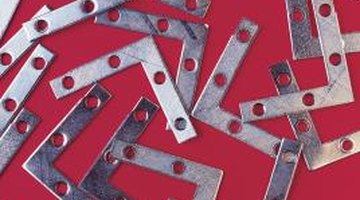How to Determine the Angle for Braces for a Shelf
Without braces to help prop it up, a shelf may buckle from the weight of the items on it. This warps the wood over time. With heavier items, the shelf may crack or break from the wall. Braces or brackets bolster a shelf, helping it to support the weight it holds. You should choose a brace whose angle matches the shelf's configuration. If you don't know the angle that the shelf makes with the wall, you can calculate it using trigonometry.

Step 1
Measure the shelf's depth, which is the distance it extends from the wall. For example, suppose that a shelf extends 12 inches from the wall.
Step 2
Hold a carpenter's level below the shelf perpendicular to the wall. The level's bubble will float to the center of its tube when it is horizontal. Depending on the shelf's angle, the level may make contact with the shelf's back or front.
Step 3
Measure the horizontal distance along the level between the wall and the front of the shelf. For example, suppose that this distance measures 11.5 inches.
Step 4
Divide the second measurement by the first. In the example, 11.5 divided by 12 is 0.958.
Step 5
Find the inverse cosine of this ratio on a scientific calculator. The inverse cosine of 0.958 is 16.66.
Step 6
Identify whether the level touched the front or back of the shelf in step 2. If the level touched the front of the shelf, the brace must be less than 90 degrees. Subtract 16.66 from 90, giving 73.33 degrees. If the level touched the back of the shelf, the brace must be more than 90 degrees. Add 16.66 to 90, giving 106.66 degrees.
References
Resources
Tips
- Shelves most often meet the wall at right angles, which measure 90 degrees. In this case, you can use a 90-degree brace without calculating the shelf's angle.
Writer Bio
Ryan Menezes is a professional writer and blogger. He has a Bachelor of Science in journalism from Boston University and has written for the American Civil Liberties Union, the marketing firm InSegment and the project management service Assembla. He is also a member of Mensa and the American Parliamentary Debate Association.
Photo Credits
- Comstock Images/Comstock/Getty Images
More Articles
- How to Remove an LG Tromm Laundry Detergent Dispenser
- How to Clean Burnt Food in a Paderno Frying Pan
- How Do I Change My Coleman Hot Tub From Economy Mode to Standard?
- How to Attach the Door Front to a Whirlpool Integrated Dishwasher
- How to Remove the Shelves in a Frigidaire Freezer
- How to Remove a Thermador MBBS from a SMW272



